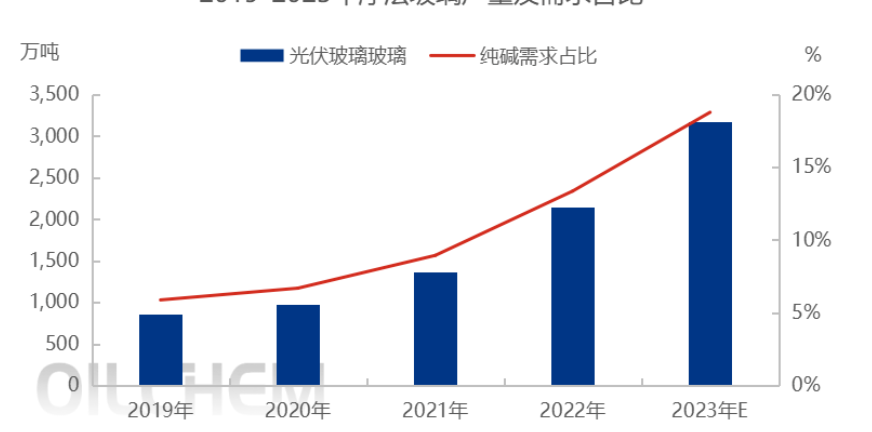Pure alkali is an inorganic chemical, and the downstream involves more consumption. From the lower downstream consumption structure of pure alkali, the consumption of pure alkali is mainly concentrated in float glass, daily glass, photovoltaic glass, sodium bicarbinate, sodium silicate, etc., which accounts for 82.39%. Second, detergent, MSG, lithium carbonate, alumina and his products. The increase of the demand of pure alkali downstream in 2023 was mainly concentrated in the products such as light and lithium, and the total amount of water, glass, glass and sodium carbonate was decreased respectively, and the decrease of the amount of sodium carbonate was decreased by 2.81%, 2.01%, 1.65%respectively, and other downstream changes were small and stable.
From 2019 to 2023, China’s soda ash consumption showed an increasing trend year by year, with a compound annual growth rate of 3.59% in the past five years. Among them, soda ash consumption in 2023 reached 30.485,900 tons, an increase of 5.19% compared with 2022. From the perspective of mainstream downstream sub-industries, the demand for soda ash increased rapidly mainly in photovoltaic glass, lithium carbonate, monosodium glutamate and other industries, with a compound growth rate of 38.48%, 27.84% and 8.11% in the past five years, respectively. The decline in demand for soda ash products is mainly reflected in daily glass, sodium silicate, etc., the compound growth rate of the past five years is -1.51%, -2.02%. Other mainstream downstream fluctuations in 1-2%, the past five years float glass compound growth rate of 0.96%, detergent 0.88%, sodium bicarbonate 2%.
Soda ash is an important raw material in the float glass production process, which is indispensable and has no substitute. Longzhong Information data statistics, 2023 float glass production of 60.43 million tons, a year-on-year decrease of 1.08 million tons, down 1.76%, the second half of 2022 cold repair production line more, leading to the overall supply performance in 2023 downward trend. After experiencing a supply decline in 2022, the overall recovery stage in 2023, the ignition production line increased, and the daily melting volume rose. As of August, daily production was 6.8% higher than at the start of the year. And the real estate industry boom continues to be low, especially the terminal capital turnover problem, to a large extent suppressed the purchase and digestion of float glass in the middle and downstream. However, due to the continued low level of the original film reserves in the middle and downstream, the demand gradually started at the beginning of the year, and the subsequent stage of a small improvement, as well as the relevant policies of the state in guaranteeing the exchange of buildings, stimulating consumption and financial funds, also led to the market sentiment of the industry and the downstream replenishment operation, which led to the volatility of the market, and the overall price was significantly better than last year. The profit situation has gradually turned a loss into a profit and has become relatively substantial.
With the successive production lines, the daily melting volume increased, and the soda ash consumption maintained an increasing trend. For this year, some production lines are expected to resume production and new investment, and individual production lines are cold repaired, but the net production capacity continues to rise, and soda ash consumption shows an increasing trend. In 2022, the annual output of float glass will be 61.501 million tons, and soda ash consumption will account for 42.45%. In 2022, the float glass market was weak, the industry losses continued in the second half of the year, the cold repair enterprises increased, and the glass production declined, resulting in the overall production of the year lower than that of 2021, and the soda ash consumption declined. In 2021, the float industry is running strongly, demand is boosted, float production capacity is released, soda ash demand is increased, and soda ash accounts for a high proportion. In 2019-2020, float glass production is relatively stable, and soda ash consumption fluctuates little.
In recent years, the production capacity of the photovoltaic glass industry has been intensively released, and the supply has been rapidly improved. According to the statistics of Longhong Information, the output of photovoltaic glass in 2023 will be 31.78 million tons, an increase of 10.28 million tons, or 47.81%, compared with 2022. In 2023, the pace of photovoltaic glass production expansion has slowed down compared with 2022, and a total of 15 new kilns have been added throughout the year, with an additional daily capacity of 16,000 tons, and by the end of the year, the industry’s production capacity has increased to 91,000 tons/day. Compared with the previous integration planning, the production of photovoltaic glass kilns in 2023 is partly delayed, the main reasons are two, one is the market cooling, low profits, manufacturers independent production willingness is low, the second is the tightening trend at the policy end, we are more cautious about new projects, the production pace slowed down.

Post time: Oct-31-2023





